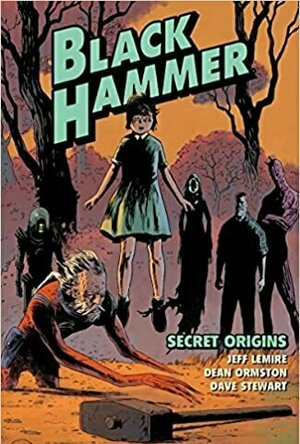
Diffords Cocktails #8 HD
Lifestyle and Entertainment
App
Cocktails #8 is the top drinks app according to 'The Sunday Times App list', their definitive guide...

Accelerated GWT: Building Enterprise Google Web Toolkit Applications
Book
Ajax is a web development technique that takes advantage of JavaScript to display and interact...
Joe Goodhart (27 KP) rated Black Hammer, Vol. 1: Secret Origins in Books
Nov 30, 2020
The series pays more than enough clever homage to the Silver Age heroes. Barbalien bears more than a passing resemblance to J'onn J'onz in the DC Universe, while Golden Gail shares notable similarities to Shazam, or Captain Marvel, also from DC. However, despite the similarities, Jeff Lemire's intent is purely nostalgia and respect, nothing resembling fan service by any means!
Despite aspects of the series that clearly apply to the superhero genre, this series anything but a typical superhero book. Instead, we are presented with a dark (and I mean DARK, like you'll want a milkshake or some Insomnia Cookies after you are finished reading it) tale that is very much about the people who embody the heroes in the series. There are a lot of human struggles and internal issues, all dealt with in a well-written manner, the end result of a series created out of love for the comic heroes of old.
Jeff Lemire is swiftly becoming one of my favorite writers. I got sucked in with his recent new series, GIDEON FALLS, and then now this. I know everyone else has been a fan for the longest time, but regardless, I consider myself a fan now, too! :)
As praise as I am throwing Lemire's way, I also need to throw some to Dean Ormston, the series' A-MAZ-INGLY talented artist! His art suited Lemire's ideas and concepts, rendering them in a way that further supported the tribute to the Silver Age that this clearly was. I glad Ormston remained the artist, as it helped to maintain continuity without breaking the mood.
In closing, I just want to say a big thank you to Baxter for the recommendation and thank you to Comixology and Dark Horse for the sale! My new found love of this series is now forever owned to you both, as well as Msrs. Lemire and Ormston! THANK YOU!!

Foresee: Your Personal Activity Forecast
Weather and Productivity
App
WEATHER-POWERED ACTIVITY PLANNER... Foresee intelligently predicts the ideal times for your...

Magic Eye Color-Face Makeup Plus&Red Eyes Remover
Beauty, Entertainment and Photo & Video
App
∆Over 7,000,000 downloads!∆ Featured on the iTunes Home Page in "New and Noteworthy" , "What's...

Martha Stewart's Homekeeping Handbook
Book
Whether your home is small or large, an apartment in the city or a country cottage, it is a space...
homekeeping household maintenance housework diy kitchen

Generation of Vipers
Book
Rosabella Moore-Davis has just moved her husband halfway across the world, with a spur of the moment...
Adult Gothic Psychological Thriller

World Offline Maps + Voice Navigator and Video Dash Cam
Travel and Navigation
App
SAVE HUNDREDS OF EUROS IN ROAMING COST WHEREVER YOU GO. Updated maps, very fast and beautiful....

Dineout: Reserve a Table
Food & Drink and Lifestyle
App
Dineout is a restaurant reservation app that helps you search across various cuisines, deals,...

The Super Metabolism Diet: The Two-Week Plan to Ignite Your Fat-Burning Furnace and Stay Lean for Life!
David Zinczenko and Keenan Mayo
Book
TORCH FAT, LOOK YOUNGER, AND START LOSING YOUR BELLY—IN JUST 14 DAYS! NBC News health and...
health and fitness
